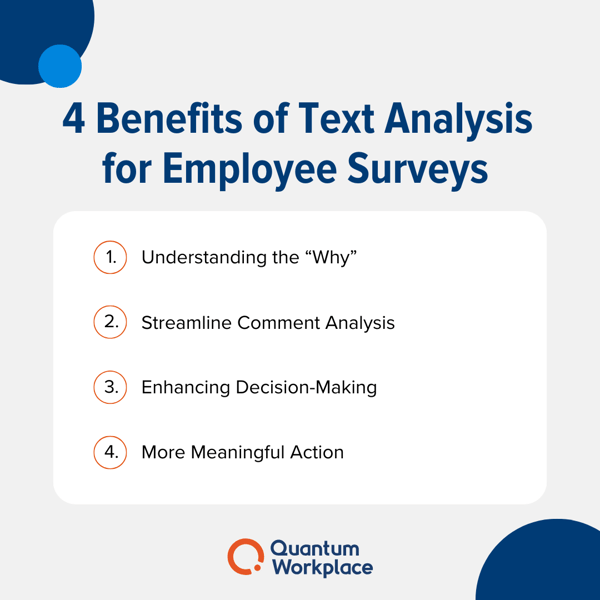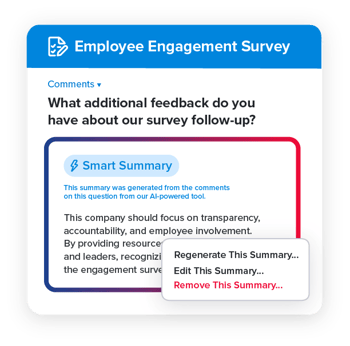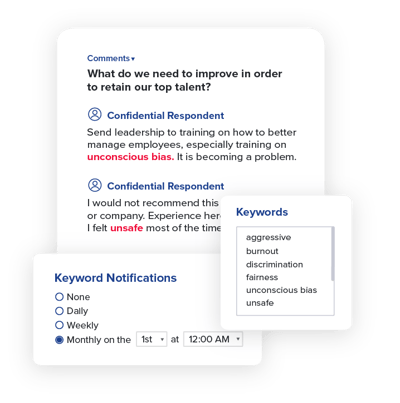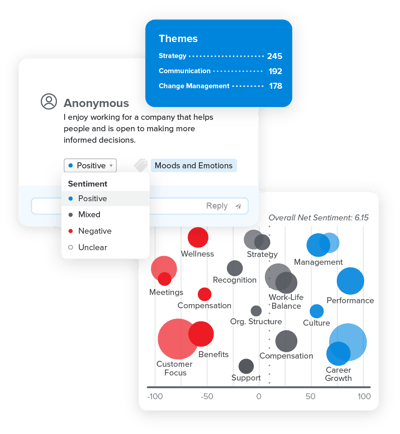The quest to understand and improve employee engagement is a top priority for HR leaders and managers alike. Employee engagement surveys have become a must-have tool to help organizations understand employee perceptions and make better business decisions.
But there is one notoriously difficult component of understanding employee feedback at scale: open-ended survey responses.

Open-ended responses (employee survey comments) are essential in understanding the nuances of employee sentiment and identifying reasons for engagement gaps. While quantitative data gives you an objective baseline, qualitative data helps you uncover the real narrative behind the data. And text analytics helps you bring these stories to life in real time so you can act on them.
But analyzing open-ended responses has proven to be a daunting task, especially in organizations dealing with a large workforce with hundreds or even thousands of employee survey comments in a single survey. It’s a cumbersome and manual process to make sense of this data without the right tools.
Tools that leverage artificial intelligence (AI) and text analysis can help save HR teams and managers time by streamlining comment analysis. You can uncover hidden insights that add important context to your employee engagement focus areas and action plans. Ultimately, these tools help bring clarity to your business leaders while helping employees feel heard—a win-win for employee engagement.
What Are Open-Ended Responses?
In employee surveys, open-ended responses are free-text comments that provide employees with an opportunity to express their thoughts, concerns, and suggestions in their own words. These responses serve as a valuable source of qualitative data, offering a narrative perspective that complements the quantitative data gathered through structured survey questions.
Examples of Open-Ended Survey Questions
Your survey shouldn’t include too many open-ended questions—try to stick to 1-3. Sticking with a small number of these questions allows you to focus on the items that will have the most impact without frustrating your survey participants.
At Quantum Workplace, we like to ask a series of Start/Stop/Continue questions. Not only are these concise and easy to answer, but they can provide actionable insight into what your employees love about your organization—and how to prioritize for impact.
- What is one thing you would like us to START doing to make it a better place to work?
- What is one thing you would like us to STOP doing to make it a better place to work?
- What is one thing you would like us to CONTINUE doing that makes it a great place to work?
Why Are Open-Ended Responses Important?
Open-ended responses add depth and color to employee survey analytics, providing a human touch to the otherwise numerical data. Employee survey comments bring power and meaning to quantitative results, painting a more in-depth picture around the numbers and charts. They allow employees to express themselves in their own words, shedding light on their experiences and emotions at work.
It’s important to read, analyze, and take action on your open-ended responses just like you do with your quantitative data. Text analysis helps leaders, HR, and managers do this in an efficient way.
What is Text Analysis?
Text analysis, also known as text analytics, is the process of converting unstructured text data into structured, actionable insights. It involves various techniques, including natural language processing (NLP), sentiment analysis, and keyword tracking, to extract valuable information from text.
4 Benefits of Text Analysis for Employee Surveys

1. Understanding the "Why"
Text analysis helps you dive deep into the narratives within open-ended responses, providing insights into the underlying reasons behind employee sentiment.
2. Streamlines Comment Analysis
Text analytics help HR leaders and managers overcome the challenges of analyzing vast amounts of unstructured data, making the process more manageable and insightful.
3. Enhancing Decision-Making
Text analytics allows leaders and managers to make data-driven decisions based on a richer understanding of employee feedback.
4. More Meaningful Action
Using text analysis to dive into open-ended responses helps teams develop better action plans. Instead of looking at broad trends on survey questions and guessing what effective action might look like, teams can dig into specific areas and source ideas for improvement.
Text Analytics Tools: How Quantum Workplace Can Help
Quantum Workplace’s employee surveys are set up to easily enable open-ended comments to add context to any survey item. This helps organizations uncover deeper meaning in their surveys, leading to more robust insights and more effective action.
Narrative Insights, a cutting-edge solution by Quantum Workplace, is here to revolutionize the way HR professionals approach the challenge of analyzing survey comments. By harnessing the power of text analytics and AI, Narrative Insights transforms mountains of open-ended responses into actionable insights, making it easier than ever to understand how employees feel and address employee concerns.
Our AI model meticulously analyzes survey comments and provides quick summaries, highlights themes, identifies sentiments, and even detects emerging risks, all in real-time. Narrative Insights helps:
- Speed up survey comment analysis for HR leaders and managers
- Quickly gauge what employee care about most
- Gain valuable context through confidential, two-way dialogue
- Proactively address sensitive topics surfaced by open-ended responses
AI-Powered Smart Summary
Smart Summary utilizes AI to automatically generate employee comment summaries for nearly any survey question. Since no data model is perfect, users have the flexibility to regenerate or manually update each comment summary within the Comments report.
This feature enables users to easily uncover the meaning behind open-ended employee responses at scale across many different groups or demographics.
|
 |
 |
Keyword Detection
Keyword Detection monitors keywords and phrases in comments that are sensitive in nature. When a tracked keyword shows up in survey comments, users receive a notification that displays how many times it was mentioned.
Users can also filter the results by any survey and see the top ten most frequently used keywords displayed as colored tiles. The size of each tile corresponds to the frequency of the keyword's usage.
This feature enables users to easily organize, and view survey comments based on tracked keywords or phrases that may require prompt follow-up action.
|
Theme & Sentiment Analysis
Sentiment and Theme Analysis identifies key topics and sentiment for each survey comment. Our technology tags each comment with one of 34 common themes and labels the sentiment as positive, negative, mixed, or unclear. Users have the flexibility to manually update or change the theme or sentiment within the Comments report.
This feature streamlines survey comment analysis allowing users to quickly assess and improve employee satisfaction.
Theme Sentiment Distribution
The Theme Sentiment Distribution chart combines theme frequency relative to sentiment for a comprehensive overview of survey comments. This enables users to visualize how different themes are associated with positive, negative, mixed, or unclear sentiments using a bubble chart.
The more negative a theme’s sentiment, the further left it will appear on the chart. And the more positive a theme’s sentiment, the further right it will appear. The size of each bubble reflects how frequently a particular theme appears in the comments. If a bubble is larger, it means the theme appears more frequently in the comments.
This feature gives users a visual to quickly assess the prevalence of specific themes and their sentiment in survey comments.
|

|
Data Security
Comment summaries are generated using AI. Our platform, including our employee engagement surveys, analytics, and AI models for comment summarization, is hosted on a leading cloud service provider known for its robust security infrastructure.
Here's how we ensure the security and privacy of your data:
- Secure Hosting: We utilize models provided by our cloud service provider to analyze your survey data. While these models are shared resources, each interaction is isolated, ensuring that your data does not interact with data from other customers.
- Data Protection: The data we process through these models, including the comments from your employees on engagement surveys, are protected with the same stringent security measures we apply across our platform. This includes encryption at rest using advanced encryption standards, secure data transmission, and strict access controls.
- Data Privacy and Use: We respect your data privacy. The data processed through these models is not used to improve the models or any third-party products or services.
Conclusion
In today's data-driven HR landscape, understanding employee sentiment is crucial for organizational success. Open-ended responses provide valuable insights into employee perspectives, but the challenge lies in effectively analyzing and interpreting this data. Text analysis, powered by AI, bridges this gap, providing organizations with actionable insights from qualitative data.
Quantum Workplace's Narrative Insights empowers HR professionals to unlock the true potential of open-ended responses. By swiftly and accurately analyzing survey comments, it helps organizations identify emerging risks, address sensitive topics, and gain valuable context from employee feedback.

What Are Open-Ended Responses?
Why Are Open-Ended Responses Important?
What is Text Analysis?
Text Analytics Tools: How Quantum Workplace Can Help
Share
How to Analyze Open-Ended Responses from Employee Survey Comments with Text Analytics
The quest to understand and improve employee engagement is a top priority for HR leaders and managers alike. Employee engagement surveys have become a must-have tool to help organizations understand employee perceptions and make better business decisions.
But there is one notoriously difficult component of understanding employee feedback at scale: open-ended survey responses.
Open-ended responses (employee survey comments) are essential in understanding the nuances of employee sentiment and identifying reasons for engagement gaps. While quantitative data gives you an objective baseline, qualitative data helps you uncover the real narrative behind the data. And text analytics helps you bring these stories to life in real time so you can act on them.
But analyzing open-ended responses has proven to be a daunting task, especially in organizations dealing with a large workforce with hundreds or even thousands of employee survey comments in a single survey. It’s a cumbersome and manual process to make sense of this data without the right tools.
Tools that leverage artificial intelligence (AI) and text analysis can help save HR teams and managers time by streamlining comment analysis. You can uncover hidden insights that add important context to your employee engagement focus areas and action plans. Ultimately, these tools help bring clarity to your business leaders while helping employees feel heard—a win-win for employee engagement.
What Are Open-Ended Responses?
In employee surveys, open-ended responses are free-text comments that provide employees with an opportunity to express their thoughts, concerns, and suggestions in their own words. These responses serve as a valuable source of qualitative data, offering a narrative perspective that complements the quantitative data gathered through structured survey questions.
Examples of Open-Ended Survey Questions
Your survey shouldn’t include too many open-ended questions—try to stick to 1-3. Sticking with a small number of these questions allows you to focus on the items that will have the most impact without frustrating your survey participants.
At Quantum Workplace, we like to ask a series of Start/Stop/Continue questions. Not only are these concise and easy to answer, but they can provide actionable insight into what your employees love about your organization—and how to prioritize for impact.
Why Are Open-Ended Responses Important?
Open-ended responses add depth and color to employee survey analytics, providing a human touch to the otherwise numerical data. Employee survey comments bring power and meaning to quantitative results, painting a more in-depth picture around the numbers and charts. They allow employees to express themselves in their own words, shedding light on their experiences and emotions at work.
It’s important to read, analyze, and take action on your open-ended responses just like you do with your quantitative data. Text analysis helps leaders, HR, and managers do this in an efficient way.
What is Text Analysis?
Text analysis, also known as text analytics, is the process of converting unstructured text data into structured, actionable insights. It involves various techniques, including natural language processing (NLP), sentiment analysis, and keyword tracking, to extract valuable information from text.
4 Benefits of Text Analysis for Employee Surveys

1. Understanding the "Why"
Text analysis helps you dive deep into the narratives within open-ended responses, providing insights into the underlying reasons behind employee sentiment.
2. Streamlines Comment Analysis
Text analytics help HR leaders and managers overcome the challenges of analyzing vast amounts of unstructured data, making the process more manageable and insightful.
3. Enhancing Decision-Making
Text analytics allows leaders and managers to make data-driven decisions based on a richer understanding of employee feedback.
4. More Meaningful Action
Using text analysis to dive into open-ended responses helps teams develop better action plans. Instead of looking at broad trends on survey questions and guessing what effective action might look like, teams can dig into specific areas and source ideas for improvement.
Text Analytics Tools: How Quantum Workplace Can Help
Quantum Workplace’s employee surveys are set up to easily enable open-ended comments to add context to any survey item. This helps organizations uncover deeper meaning in their surveys, leading to more robust insights and more effective action.
Narrative Insights, a cutting-edge solution by Quantum Workplace, is here to revolutionize the way HR professionals approach the challenge of analyzing survey comments. By harnessing the power of text analytics and AI, Narrative Insights transforms mountains of open-ended responses into actionable insights, making it easier than ever to understand how employees feel and address employee concerns.
Our AI model meticulously analyzes survey comments and provides quick summaries, highlights themes, identifies sentiments, and even detects emerging risks, all in real-time. Narrative Insights helps:
AI-Powered Smart Summary
Smart Summary utilizes AI to automatically generate employee comment summaries for nearly any survey question. Since no data model is perfect, users have the flexibility to regenerate or manually update each comment summary within the Comments report.
This feature enables users to easily uncover the meaning behind open-ended employee responses at scale across many different groups or demographics.
Keyword Detection
Keyword Detection monitors keywords and phrases in comments that are sensitive in nature. When a tracked keyword shows up in survey comments, users receive a notification that displays how many times it was mentioned.
Users can also filter the results by any survey and see the top ten most frequently used keywords displayed as colored tiles. The size of each tile corresponds to the frequency of the keyword's usage.
This feature enables users to easily organize, and view survey comments based on tracked keywords or phrases that may require prompt follow-up action.
Theme & Sentiment Analysis
Sentiment and Theme Analysis identifies key topics and sentiment for each survey comment. Our technology tags each comment with one of 34 common themes and labels the sentiment as positive, negative, mixed, or unclear. Users have the flexibility to manually update or change the theme or sentiment within the Comments report.
This feature streamlines survey comment analysis allowing users to quickly assess and improve employee satisfaction.
Theme Sentiment Distribution
The Theme Sentiment Distribution chart combines theme frequency relative to sentiment for a comprehensive overview of survey comments. This enables users to visualize how different themes are associated with positive, negative, mixed, or unclear sentiments using a bubble chart.
The more negative a theme’s sentiment, the further left it will appear on the chart. And the more positive a theme’s sentiment, the further right it will appear. The size of each bubble reflects how frequently a particular theme appears in the comments. If a bubble is larger, it means the theme appears more frequently in the comments.
This feature gives users a visual to quickly assess the prevalence of specific themes and their sentiment in survey comments.
Data Security
Comment summaries are generated using AI. Our platform, including our employee engagement surveys, analytics, and AI models for comment summarization, is hosted on a leading cloud service provider known for its robust security infrastructure.
Here's how we ensure the security and privacy of your data:
Conclusion
In today's data-driven HR landscape, understanding employee sentiment is crucial for organizational success. Open-ended responses provide valuable insights into employee perspectives, but the challenge lies in effectively analyzing and interpreting this data. Text analysis, powered by AI, bridges this gap, providing organizations with actionable insights from qualitative data.
Quantum Workplace's Narrative Insights empowers HR professionals to unlock the true potential of open-ended responses. By swiftly and accurately analyzing survey comments, it helps organizations identify emerging risks, address sensitive topics, and gain valuable context from employee feedback.
Subscribe to our blog
Get the latest insights on engagement, performance, and culture straight to your inbox.
Related Content
How to Uncover Meaning with Your Employee Survey Analytics
Employee Engagement Survey Guide (and Research-Backed Survey Questions)
21 Employee Engagement Survey Questions Proven to Help Measure Engagement
[eBook] Unlocking Employee Engagement
Latest Articles
How to Select the Best Performance Management System Software in 2025
How to Choose the Best Employee Engagement Software in 2025
From Data to Decisions: The Science of Measuring Employee Engagement
Explore more